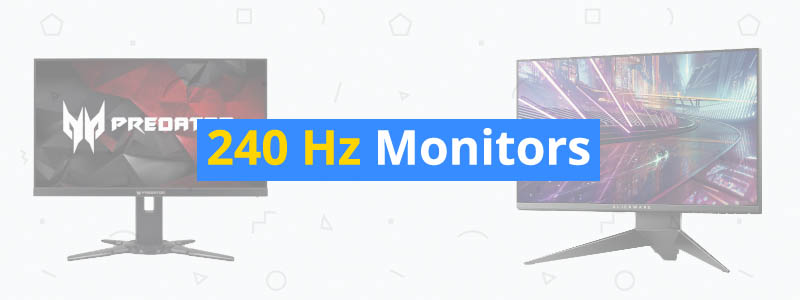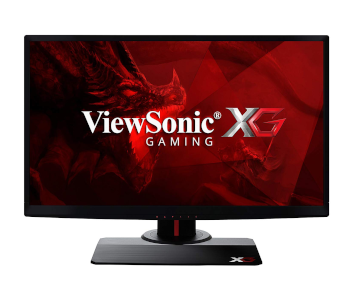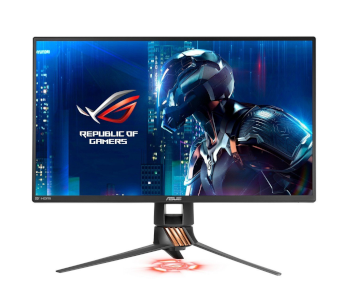5 Best 240 Hz Monitors
If a monitor with a 144 Hz native refresh rate is still not enough for you, consider getting one of the best 240 Hz monitors – but don’t just pick the most popular product that comes up on Amazon search. While there are several good options on the market, not all of them are worth the money.
In this guide, we have compiled the top 240 Hz monitors currently out. No need to spend days examining all available options. We already narrowed down the field for you, allowing you to pick from only the best of the best.
| Budget |
|---|
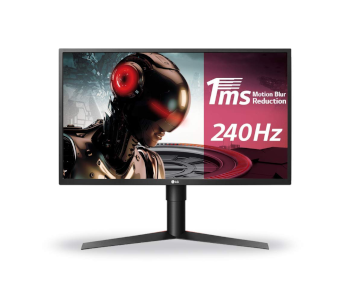 |
| LG 27GK750F-B |
| 4.0/5.0 |
| Size: 27 in |
| Resolution: 1920 x 1080 |
| It has AMD FreeSync support and intuitive joystick control. |
| Check Amazon |
| Best Value |
|---|
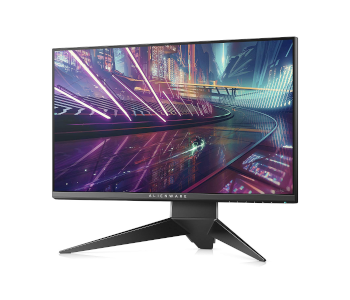 |
| Dell Alienware AW2518HF |
| 4.2/5.0 |
| Size: 25 in |
| Resolution: 1920 x 1080 |
| Has customizable gaming presets and good ergonomics. |
| Check Amazon |
| Top Pick |
|---|
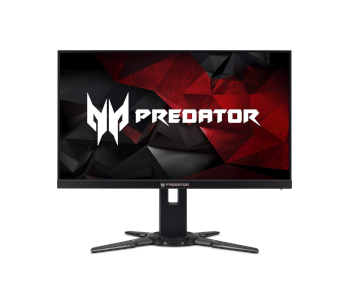 |
| Acer Predator XB252Q |
| 4.4/5.0 |
| Size: 25 in |
| Resolution: 1920 x 1080 |
| This has excellent input lag and fast response time. |
| Check Amazon |
Monitors with a 240 Hz native refresh rate – this means no overclocking is required – are not for everyone. They have pros and cons that you need to consider before you buy one, especially since they don’t come cheap.
With 240 Hz monitors, you get to experience increased smoothness when playing fast-paced games like Counter-Strike: Global Offensive. Such monitors are best suited for high-level competitive gaming in which even a split-second difference in reaction time can mean the difference between victory and defeat. If you mainly play first-person shooter games on a high level, can actually tell the difference between 144 Hz and 240 Hz, and, more importantly, have a powerful graphics card that can consistently pump out 200+ frames per second, then 240 Hz monitors are for you.
But the problem with current 240 Hz monitors is that all of them use TN panels, which means you get mediocre viewing angles, a low native contrast, and unremarkable picture quality overall. In addition, all products currently out are only 1080p, which makes their high prices unjustifiable for a lot of people. It’s also worth noting that not all games can consistently reach over 200 frames per second, so 240 Hz monitors will only be truly beneficial for certain games.
Whether or not a 240 Hz monitor is worth buying depends on what you plan to do on it. If you want a gaming monitor that will also work well for productivity and media consumption, we recommend IPS monitors with a high resolution instead. But if you are going to use your monitor strictly for competitive gaming, getting a 240 Hz monitor will be worth it – but only if you are coming from a 60 Hz monitor. If you are still rocking a very good 144 Hz monitor, you might want to hold off on upgrading to a 240 Hz monitor.
As you can see, there are a lot of ifs involved when it comes to 240 Hz monitors. It’s considered a niche category, though not on the same level as 5K monitors. Again, such monitors are not for everyone, so only pull the trigger on the top 240 Hz monitors listed in this guide if you are absolutely cool with what they bring to the table, both good and bad.
240 Hz Monitors Comparison Table
| Make and Model | Rating | Size | Resolution | Refresh Rate | Response Time | Panel Type | Weight | Price |
|---|---|---|---|---|---|---|---|---|
| Acer Predator XB252Q | 4.4 | 25 in | 1920 x 1080 | 240 Hz | 1 ms | TN | 13.5 lb | Check Price |
| LG 27GK750F-B | 4.0 | 27 in | 1920 x 1080 | 240 Hz | 2 ms | TN | 14 lb | Check Price |
| Dell Alienware AW2518HF | 4.2 | 25 in | 1920 x 1080 | 240 Hz | 1 ms | TN | 14.5 lb | Check Price |
| ViewSonic XG2530 | 4.0 | 25 in | 1920 x 1080 | 240 Hz | 1 ms | TN | 14.9 lb | Check Price |
| Asus ROG Swift PG258Q | 4.3 | 25 in | 1920 x 1080 | 240 Hz | 1 ms | TN | 12.4 lb | Check Price |
1. Best Pick: Acer Predator XB252Q
Editor’s Rating: 4.4/5
The Acer Predator XB252Q is the best 240 Hz monitor that you can get today, especially if you have a powerful Nvidia graphics card. It sells for about $500, which makes it cheaper than its main competition, the Asus ROG Swift PG258Q.
Regarding aesthetics, the XB252Q is significantly more discreet than Asus’s offering, featuring a more industrial design with a basic back panel design. It has a well-built frame with thin bezels on the top and sides and comes with a stand with an X-shaped base. The stand, which has a small hole for cable management, easily supports the screen. It has good ergonomics, with options to adjust the height as well as tilt and swivel the screen.
The XB252Q’s OSD controls, composed of buttons and a joystick, are on the bottom-right corner, but instead of under the frame, they are at the back. While not as good as those found on LG monitors, the joystick control is responsive and easy to use, which makes navigating the OSD more convenient. The OSD itself is well designed, with a good selection of options.
Concerning connectivity, the XB252Q is generous. It has an HDMI port, a DisplayPort, an audio out, and four USB 3.0 downstream ports, one of which can be used for fast charging. Of the four USB downstream ports, two are side-facing on the monitor’s left edge for quick access – like with some of Dell’s professional monitors, such as the Dell P2417H, which also makes for a good console gaming monitor.
Acer outfitted the XB252Q with a pair of speakers – but don’t use them unless you have no other option because they sound awful, which might disappoint those expecting at least a decent sound quality, considering the price. For gaming, it’s best to use headsets, most especially for team-based multiplayer games such as Overwatch and Counter-Strike: Global Offensive.
When it comes to gaming performance, the XB252Q is just as advertised. It has a fast response time and a very low input lag, making it an excellent monitor for fast-paced competitive games, including the titles above. A G-Sync monitor, the XB252Q offers extremely smooth, tear-free gaming, with minimal motion blur during action-packed games.
Since the XB252Q is a TN monitor, you shouldn’t expect too much regarding color accuracy and overall picture quality. It has mediocre viewing angles, which means you always need to sit right in front of it to get the best viewing experience. Additionally, it has a low native contrast ratio and is not a good monitor for gaming in a dark room. But on the plus side, the XB252Q has better out-of-the-box color accuracy than the Asus ROG Swift PG258Q.
Overall, the XB252Q is a great monitor for fast-paced games, especially first-person shooter games. It has a solid build quality with good ergonomics, and offers a buttery smooth performance, assuming your graphics card is also on point. If you can pop $500 for a monitor with a 240 Hz native refresh rate, the XB252Q is the best option right now.
| Tech Specs |
|---|
| Size: 25 in |
| Resolution: 1920 x 1080 |
| Refresh Rate: 240 Hz |
| Response Time: 1 ms |
| Panel: TN |
| Weight: 13.5 lb |
| The Pros |
|---|
| Nvidia G-Sync support |
| Excellent input lag |
| Fast response time |
| Good ergonomics |
| Responsive OSD controls |
| Good connectivity options |
| The Cons |
|---|
| Expensive |
| Poor viewing angles |
| Low native contrast ratio |
2. Best Budget: LG 27GK750F-B
Editor’s Rating: 4/5
If our top pick is way too expensive for you, consider the LG 27GK750F-B instead. It’s one of the most affordable 240 Hz monitors on the market, selling for just around $300, which makes it even cheaper than the ViewSonic XG2530. It’s a great monitor for pure gaming, with better out-of-the-box color accuracy than most budget TN monitors.
Of the products in this guide, the 27GK750F-B easily stands out due to its 27-inch screen, considering almost all 240 Hz monitors come with 25-inch screens. Like all other products on this list, it’s got a 1920 x 1080 resolution, but its pixel density is 82 pixels per inch. While the larger screen is welcome for some, others might balk at the lower pixel density.
Among other LG offerings, the 27GK750F-B also stands out due to its aesthetics. It’s clearly made with gamers in mind, much more so than other LG gaming monitors. It has a well-built frame with narrow borders on all sides and comes with a stable stand with a wide footprint. Instead of being curved, as seen on other LG monitors, the stand legs are angled.
The 27GK750F-B’s back panel is eye-catching. It has a large ring with red accents, although unlike with other gaming monitors, there’s no lighting system. Additionally, the stand legs carry the same red accents. The stand isn’t just about cosmetics, though; it’s got good ergonomics, too. You can easily adjust the screen height as well as tilt and swivel the screen for a more comfortable setup.
As with almost all other LG monitors, the 27GK750F-B’s on-screen menu is controlled via an intuitive joystick located at the bottom of the frame. The joystick is well implemented and does not feel cheaply built, with LG keeping it straightforward instead of trying to be too fancy. The OSD itself is also well organized and offers a good selection of options.
The 27GK750F-B’s ports are neatly lined up on the back panel inside the large ring. Connection options include two HDMI ports, a DisplayPort, an audio out, and a USB hub with a pair of USB 3.0 ports. You can use this monitor for console gaming, courtesy of the HDMI ports.
Concerning picture quality, the 27GK750F-B is decent for a TN monitor. It’s not on the same level as IPS monitors, of course. It has good color accuracy out of the box and can get very bright. It’s got bad viewing angles, though, so expect the picture quality to go down as you move away from the center.
While unimpressive regarding overall picture quality, the 27GK750F-B is a fantastic monitor for fast-paced competitive games such as Overwatch, Rocket League, and Call of Duty: Black Ops 4. It has an excellent input lag and a very fast response time, making it suitable for games that require quick reactions.
The 27GK750F-B has excellent motion handling and features AMD FreeSync support for a much smoother performance when the framerate fluctuates. It’s a monitor built specifically for gaming, boasting features such as presets for certain genres, a motion blur reduction feature that supports up to 240 Hz, and a Black Stabilizer option.
In all, the 27GK750F-B is the best budget 240 Hz monitor on the market. It’s around $200 cheaper than our top pick, which is a considerable amount. If you want to get into 240 Hz gaming but can’t afford to spend too much on a monitor, this product is for you. It has FreeSync support, a fast response time, and good color accuracy out of the box.
| Tech Specs |
|---|
| Size: 27 in |
| Resolution: 1920 x 1080 |
| Refresh Rate: 240 Hz |
| Response Time: 2 ms |
| Panel: TN |
| Weight: 14 lb |
| The Pros |
|---|
| Low price |
| AMD FreeSync support |
| Intuitive joystick control |
| Fast response time |
| Low input lag |
| Good color accuracy out of the box |
| The Cons |
|---|
| Bad viewing angles |
| Not good for gaming in a dark room |
3. Best Value: Dell Alienware AW2518HF
Editor’s Rating: 4.2/5
Dell is one of the best brands when it comes to monitors, whether it’s for gaming or professional use. For hardcore gamers, the American company offers the AW2518HF, sold under the gaming-focused Alienware brand. It’s a 25-inch monitor with FreeSync support, with Dell also offering a G-Sync model.
If you own an AMD graphics card or don’t plan to use variable refresh rate tech, the AW2518HF offers the better value for the price. If, however, you own a Nvidia GPU and plan to use G-Sync tech, you’ll be better off with our top pick from Acer instead. You can get this Alienware monitor for around $400, which puts it close to our top pick’s price range.
Alienware products are known for their highly attractive aesthetics, and this product is no exception. Of the monitors in this guide, the AW2518HF is, hands down, the most appealing, featuring a futuristic design from top to bottom. It has very thin bezels and a stylish back panel.
The stand, which has sharp angles, has cable management at the bottom and offers good ergonomics, with height adjustment, tilt, pivot, and swivel options. The AW2518HF has a large footprint, but that’s mostly due to the stand’s design. When removed from the stand, the monitor itself is fairly thin. You can easily mount this monitor on the wall, and courtesy of its thin bezels, it’ll also make for an excellent multi-monitor setup.
On the lower-right corner, under the frame, you’ll find a set of buttons for controlling the on-screen menu. While not as cool as the joystick system found on LG monitors, the buttons are easy to use and produce a nice positive feedback when pressed. As expected from a Dell monitor, the AW2518HF has a well-designed OSD with a wide range of calibration options and features.
Like our other top picks here, the AW2518HF has plenty of connection options, almost all of which are found on the back panel. You can connect this unit via DisplayPort and HDMI. In addition, it’s got a headphones port and four USB 3.0 ports, one of which has a fast charging function. Of the four USB ports, two are located at the bottom for quick access, with the headphones port sitting between them.
If you think the AW2518HF’s handsome design is impressive, wait until you get a taste of its actual gaming performance. It’s an excellent TN monitor for first-person shooters, racing simulations, and real-time strategy games. It has a very low input lag and boasts an exceptional response time, which makes it ideal for fast-paced, action-packed games. As mentioned, it offers support for AMD’s FreeSync tech, which cuts down screen tearing and stuttering.
The AW2518HF is not for all kinds of gamers, though. If you mainly play RPGs and open-world games such as The Elder Scrolls V: Skyrim and Assassin’s Creed Odyssey, you’ll be disappointed with this monitor. For a TN monitor, the AW2518HF has a decent picture quality – but compared to IPS monitors, it comes out as mediocre.
Unlike some fancy gaming monitors, the AW2518HF combines form and function in an effective manner – it’s a monitor that’s impressive in both aesthetics and performance. If you want a gaming monitor that offers a 240 Hz native refresh rate, multiple connection options, an incredibly stylish frame, and FreeSync support, get this Alienware monitor.
| Tech Specs |
|---|
| Size: 25 in |
| Resolution: 1920 x 1080 |
| Refresh Rate: 240 Hz |
| Response Time: 1 ms |
| Panel: TN |
| Weight: 14.5 lb |
| The Pros |
|---|
| Stylish design |
| AMD FreeSync support |
| Low input lag |
| Customizable gaming presets |
| Good ergonomics |
| Plenty of connection options |
| The Cons |
|---|
| Mediocre viewing angles |
| Large overall footprint |
4. ViewSonic XG2530
Editor’s Rating: 4/5
The ViewSonic XG2530 is another solid option for those willing to spend around $300-400 for a monitor with an extremely high native refresh rate. It’s a 25-inch monitor built specifically for gaming, featuring a fast response time, preset game modes, and AMD FreeSync support.
Compared to the Alienware monitor above, the XG2530 has a more discreet design for a gaming monitor, but it’s not as industrial-looking as our top pick from Acer. It has a well-built frame with a matte black finish, with a touch of red in a few areas. It has narrow bezels and a fully adjustable stand with a relatively small footprint. You can adjust the height as well as tilt and swivel the screen, along with the option to rotate to portrait mode.
The back panel has a straightforward design, with the internal speakers blaring from the top edge close to the ViewSonic logo. For connectivity, the XG2530 has two HDMI ports, a DisplayPort, an audio out, and two USB 3.0 downstream ports. All of them are at the rear and are downward-facing, which makes them a bit difficult to access when the monitor is wall-mounted or placed close to the wall.
For cable management, the monitor stand has a small loop. It’s not particularly well designed but it should get the job done. You can also rest your headphones on the retractable headphones hook at the top of the stand – although the hook isn’t wide enough to comfortably accommodate some larger headphones or headsets.
Like most monitors, the XG2530 comes with a set of buttons for the OSD. The buttons are clearly labeled and responsive; the OSD itself, however, is another story. While it includes a good selection of options, including the option to customize three settings, navigating the OSD can be very confusing. It’s going to take a while before you get used to it.
As mentioned, this gaming monitor has built-in speakers, but don’t expect too much regarding sound quality. To be blunt, the speakers sound awful – a description that won’t surprise those who know what to expect from monitor speakers. For games and movies (in case you actually plan to use this monitor for non-gaming use), we recommend that you use more capable headphones or external speakers instead.
In terms of gaming performance, the XG2530 is excellent. It’s great for games such as Overwatch, Rocket League, Battlefield 1, Fortnite, and League of Legends. It has a fast response time and a low input lag. When FreeSync is enabled, framerate fluctuations become significantly less noticeable, with the Low Framerate Compensation (LFC) function taking care of things when the framerate drops below the FreeSync range.
Gamers who value picture quality and immersion above all else will cringe upon seeing this monitor, though. Since it’s a TN monitor, the XG2530 can’t produce the kind of visuals that’d make your jaw drop. It’s decent for a TN monitor, but when compared side by side to an IPS, it gets blown away. Like all monitors with the same panel tech, the XG2530 has a low contrast ratio and mediocre viewing angles.
Overall, the XG2530 is a very good TN monitor for competitive gaming. If the Dell Alienware AW2518HF is too ostentatious for you, even for a gaming monitor, consider the XG2530 instead. It offers a very similar setup, with multiple connection options, a fast response time and low input lag, and FreeSync support.
| Tech Specs |
|---|
| Size: 25 in |
| Resolution: 1920 x 1080 |
| Refresh Rate: 240 Hz |
| Response Time: 1 ms |
| Panel: TN |
| Weight: 14.9 lb |
| The Pros |
|---|
| AMD FreeSync support |
| Decent color accuracy out of the box |
| Fully adjustable stand |
| Good connection options |
| Fast response time |
| Customizable presets |
| The Cons |
|---|
| Confusing OSD |
| Poor viewing angles |
| Low contrast ratio |
5. Asus ROG Swift PG258Q
Editor’s Rating: 4.3/5
One of the best monitors for competitive gaming, the Asus ROG Swift PG258Q is an impressive unit that delivers on almost all fronts. It’s the most expensive product on this list, selling for around $550, which is almost twice the price of our budget pick.
Unlike the Acer Predator XB252Q, the PG258Q has a more attractive frame, boasting a futuristic design with circuitry-like etches on the back panel and a lighting system on the stand. It has very thin bezels on the top and sides. The entire frame has a matte black finish, with copper accents on the stand and back panel.
The stand, which has three legs, is sturdy and supports the monitor well. It offers full adjustability, with options to tilt, swivel, pivot, and height-adjust, allowing you to set up a more comfortable position during extended gaming sessions. The stand’s lighting system projects the Republic of Gamers (ROG) logo from the underside. It’s a nice effect but it can be distracting.
For navigating the OSD, the PG258Q has an intuitive joystick on the back panel, right next to the function buttons. The joystick is responsive and easy to use, which makes navigating the OSD faster. Unlike with the ViewSonic XG2530, the PG258Q’s OSD is well organized, so it’s easy to adjust the monitor settings and enable/disable functions.
Concerning connectivity options, the PG258Q is a step below the XB252Q, not only because it offers fewer USB 3.0 ports but also because the USB ports are not easy to access. Along with the HDMI port, DisplayPort, and audio out, the USB ports are at the rear, positioned downward and covered by a piece of plastic. The XB252Q, meanwhile, has four USB 3.0 ports, two of which are on the monitor’s side for quick access.
When it comes to gaming performance, the PG258Q is a brilliant monitor, featuring an exceptionally fast response time and a very low input lag. If you mainly play games such as Rainbow Six Siege, Call of Duty: WWII, Overwatch, and Counter-Strike: Global Offensive, you’ll love this monitor. For racing games, fighting games, and MOBAs, the PG258Q is also a great monitor.
Like Acer’s offering, the PG258Q has Nvidia G-Sync support, which means you get a buttery smooth performance during fast-paced games. It has a blur reduction feature that works well, but it’s capped out at 144 Hz and can’t be enabled along with G-Sync. This means you’ll have to choose between 240 Hz and 144 Hz with blur reduction.
Considering the PG258Q uses a TN panel, you should expect the same shortcomings associated with that panel tech. It has a low native contrast ratio and mediocre viewing angles. Its default color accuracy is also off the mark, so make sure to tinker with the image settings before you start gaming for real. Compared to other TN monitors, the PG258Q has a decent picture quality, but don’t expect too much and definitely don’t use it for graphics design, photo editing, and other art-related, non-gaming tasks.
If our top pick from Acer isn’t to your liking, consider the PG258Q instead. It’s an excellent monitor for fast-paced competitive gaming, featuring G-Sync support, good ergonomics, decent connection options, and an ultra-fast response time.
| Tech Specs |
|---|
| Size: 25 in |
| Resolution: 1920 x 1080 |
| Refresh Rate: 240 Hz |
| Response Time: 1 ms |
| Panel: TN |
| Weight: 12.4 lb |
| The Pros |
|---|
| Nvidia G-Sync support |
| Good stand ergonomics |
| Fast response time |
| Low input lag |
| Intuitive joystick control |
| Very bright |
| The Cons |
|---|
| Expensive |
| Subpar out-of-box color accuracy |
| Mediocre viewing angles |
Contents

